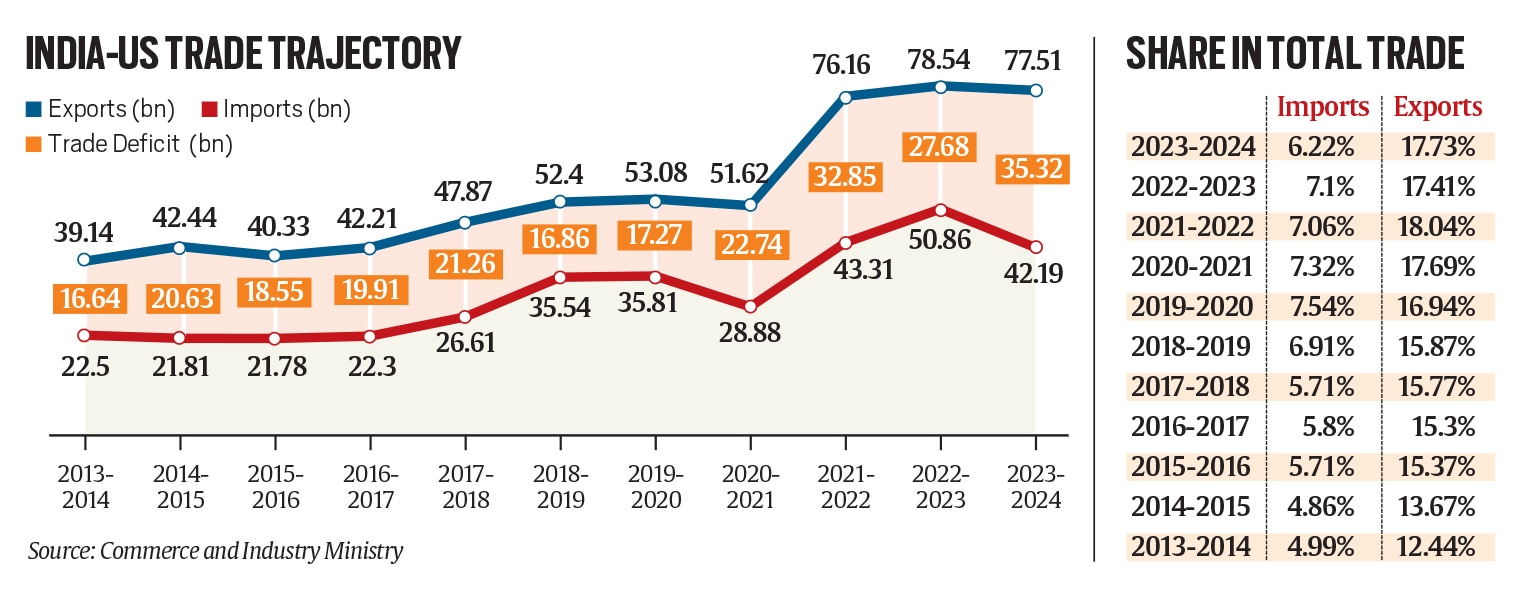The US presidential race is a toss-up between Kamala Harris and Donald Trump. If the Vice President wins, broad policy continuity with the outgoing Biden administration may be expected in a range of areas. Trump’s return could, however, bring disruption and unpredictability. For India, the impact on trade and business policy will be the most consequential.
In his campaign rhetoric, Trump has branded India a “very big [trade] abuser” — which suggests that he could renew the trade tensions of his first term, and impose higher tariffs on more than $75 billion worth of Indian exports to the US.

The tilt towards protectionism and trade isolationism of Trump 1.0 (2017-21) was not reversed under the Biden administration. Trump had blocked the World Trade Organization (WTO) dispute resolution process and invoked wartime trade provisions to launch trade conflicts with major trade partners, including India.
Story continues below this ad
In 2019, India lost duty-free access under the decades-old Generalised System of Preferences (GSP) programme, of which it had been the largest beneficiary. The tariff-free benefits accrued to approximately $5.7 billion of India’s exports to the US.
According to Bernstein Research, a Trump presidency would hit China, but the benefits for India may be “limited”, as it could come under renewed tariff pressure. The “China-plus-one” strategy may gain momentum, but the inflation resulting from trade barriers could disrupt the expected interest rate-cut trajectory, affecting middle-class consumption in India, the research note said.
 Source: Bernstein Research
Source: Bernstein Research
Indian pharmaceutical exports to the US could face setbacks, and profits may reduce for IT services firms due to a likely hardening of stance on H-1B visas, where increased rejections are expected. However, tax policies and their influence on corporate cash flows could help counterbalance the impact, the report said.
“Rupee overall is likely to see a downgrade, courtesy increased inflation and rates staying higher for longer,” it said.
Story continues below this ad
Why trade with US matters
The US is India’s largest trade partner, with bilateral trade reaching almost $120 billion in FY24 — slightly higher than India’s China trade. However, unlike China, India’s trade relationship with the US is favourable, which makes the US a vital source of foreign exchange.
 India-US trade; share of US in India’s total foreign trade.
India-US trade; share of US in India’s total foreign trade.
Despite attempts to diversify exports, India’s dependence on the US has grown over the past decade. According to official 2022-23 data, the US accounts for 18% of India’s exports, compared to 10% in 2010-11. India’s export basket to the US is well-diversified, benefiting industries ranging from textiles to electronics and engineering.
However, Trump’s promised tariffs may primarily target China, given the far larger trade imbalance. A fresh round of US-China trade wars could benefit India by taking investments and manufacturing away from China.
US, WTO, trade agreements
Over the years, the US has gradually distanced itself from the liberal global trade order that it helped establish after World War II, especially since China became a member of the WTO in 2001. China’s entry did not trigger the expected economic liberalisation; it rather led to the spread of state capitalism, impacting US job markets. In response, the US has refrained from signing new free trade agreements (FTAs), even as bipartisan calls have grown for it to withdraw entirely from the WTO.
Story continues below this ad
Frustrated by unfavourable trade dispute rulings and its inability to manage Chinese trade practices through the WTO, the Trump administration disabled the WTO’s dispute resolution function by blocking the appointments of judges, effectively leaving it inoperative for all members. Trump’s successor, Joe Biden, did not restore the system — he only pledged reforms, which are yet to take concrete shape.
High tariff walls policy…
During his first term, Trump invoked national security provisions to impose 25% tariff on steel and 10% on aluminium from India and other countries, breaking from the practice of not targeting friendly nations. Biden chose to negotiate with India and the European Union rather than lifting these tariffs.
Trump has repeatedly voiced his frustration at high tariffs in India, which affect US companies like Harley-Davidson. At a rally last month, he criticised China, Brazil, and India, and called India a “tariff king” and “trade abuser”. Notably, average tariffs in India rose to 18.1% in 2022 from 13% in 2014, which resulted in a lack of competitiveness among Indian industries compared to countries such as Vietnam, Thailand, and Mexico. India cut tariffs on several input items in the last Union Budget.
Indian policymakers argue that most countries erected high tariff walls to protect domestic industry in the early stages of growth, and that India is no different in seeking to spur manufacturing. The government has introduced production-linked incentive (PLI) schemes for 14 priority sectors, and uses tariffs to boost local production. Several clean energy manufacturing sectors continue to face stiff competition from Chinese products.
Story continues below this ad
US protectionism grew under Biden as well. Citing unfair trade practices, the US increased tariffs on Chinese electric vehicles (EVs) from 25% to 100% earlier this year. Tariffs on certain steel and aluminium products rose from 0-7.5% to 25%. These increases did not directly impact India, but they resulted in container shortages amid a surge of Chinese shipments to the US before the tariffs took effect.
…Could stoke inflation
The research organisation Peterson Institute for International Economics predicted last month that Trump’s policies — deportations, import taxes, and efforts to undermine the Federal Reserve’s independence — would significantly drive up consumer prices.
According to the Peterson analysis, inflation, which would otherwise stand at 1.9% in 2026, could rise to between 6% and 9.3% if Trump implemented his economic proposals.
Higher US inflation could hit Indian exports of labour-intensive items such as textiles, gems and jewellery, and leather products, impacting millions of jobs. Higher inflation in the US hurts India disproportionately, as the US accounts for almost 20% of all Indian exports.



 Source: Bernstein Research
Source: Bernstein Research India-US trade; share of US in India’s total foreign trade.
India-US trade; share of US in India’s total foreign trade.




































